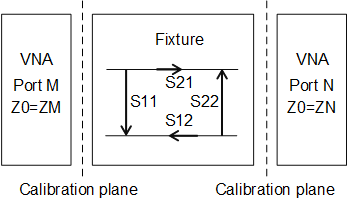Filtering method is a modified time domain gating algorithm. It is able to filter all required signals strictly according to the signal flow graph representation of a fixture, connected to a VNA. Filtering procedure is conducted at the same time for all parameters, rather than sequentially over time for each of them (i.e., the estimations of fixture parameters depend on each other).
Differences between filtering and time domain gating
Difference |
Filtering |
Traditional time domain gating algorithm |
|---|---|---|
Calculation base |
Time - Frequency model |
Time domain |
Basic algorithm |
Least mean squares |
Fourier transform |
Interpolation function |
Cubic spline |
Harmonic function |
Estimations |
Dependent (all together) |
Independent |
The filtering approach utilizes an LMS joint estimation algorithm to determine fixture parameters in accordance with a time-frequency model. Below there is an example for a THRU connection of a fixture.

Fixture (THRU connection) Measurement by Using a Calibrated VNA in the Forward Direction
VNA Residual Parameters According to the 12 (10) Term Error Model

Time - Frequency model. Reflection measurement of the THRU connection: A and B input and output reflections of a fixture, connected between calibrated VNA ports, separated by a distance (or time).
Measurement result M:

where  – time delays.
– time delays.
The model is described by a set of so-called reflectors. Each reflector has:
•Known time delays, i.e. known reflectors' positions in the time domain.
•Unknown frequency characteristics.
•Set of Reference Samples in the time-frequency plane.
The set of samples and cubic splines are used to interpolate the frequency characteristics of the reflectors.
Joint estimation of fixture parameters, obtained during reflection measurements, allows this method to separate different parts of the fixture even when signals (side lobes of impulse responses of these reflectors) according to the flow graph overlap in the time domain significantly. In other words, this algorithm potentially has a better resolution for separating signals (propagating inside the fixture) than the traditional time gating method.
Filtering supports 2xThrough and 1xReflect methods for fixture parameter definition and de-embedding.
note |
Quality of this method is defined by quality of fixture lines. In case if there are some impedance variations along fixture length, this method will degrade the accuracy. It is assumed that lines between reflectors will be quite homogeneous, and we may consider that we know where the points of reflectors are. |